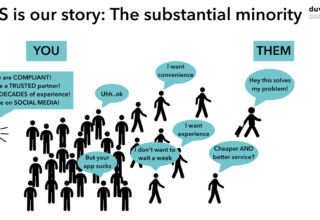A while ago we wrote about the range of consequences that could be introduced by Google getting their self-driving cars rolling. The implementation of this new technology would change (or even destroy) a serious amount of jobs and industries. Taxi drivers, car repairers, media enterprises and advertising businesses are only a few of the victims of this digital disruption. What about the insurers?
The insurance industry is already facing new challenges right now. Things will only get worse when (near) future stories like self-driving cars become reality. Let’s take a look at both occurring and future disruptive threats to see what it is up against.
5 ways in which the insurance industry will be disrupted:
The first challenge that the insurance industry (and all the other ones) is facing is the change of attitude and needs of the consumer. The rise of digital not only changed what people demand, but also disrupted how we want it to be supplied. Insurers will have to offer more personalized products for each individual.
As customers better understand insurance dynamics through independent online research, self-service will become more popular and consumers may turn to directly buying from online channels. This is where another threat pops up: peer-to-peer insurance services.
Friendsurance and Guevara are only two examples of social insurance services where friends can pool their premiums so that any unused cash at the end of the year goes towards lowering renewals the following year. They are also an example of how social networks are already bypassing the insurance companies.
And there is more. Car manufacturers have everything in hands to compete with traditional insurers. In-car technology (telematics, location awareness, etc.) will make it possible to offer one-on-one personalized car insurance instead of premiums based on industry wide statistics. Adding this up with the possibility of packaging the new insurance with these technologically advanced cars results in a profound impact on the insurance industry, changing the entire value chain from product definitions, to pricing, marketing and distribution.
 Another trend impacting the insurance business is the increasing availability of car sharing. Forbes reported in 2012 that the global car sharing market is expected to grow and could exceed 10 billion by 2020. This suggests a future in which the number of low frequency drivers increases, premiums move from 24-hour asset coverage to a new pay-per-use model and individual insurance premiums reduce.
Another trend impacting the insurance business is the increasing availability of car sharing. Forbes reported in 2012 that the global car sharing market is expected to grow and could exceed 10 billion by 2020. This suggests a future in which the number of low frequency drivers increases, premiums move from 24-hour asset coverage to a new pay-per-use model and individual insurance premiums reduce.
And then we have Google and car manufacturers like Tesla who have already built a car that can drive autonomously. All they are waiting for now is a legal framework to disrupt the insurance industry (and many other industries).
Insurance companies need to acknowledge the fact that times are changing. Don’t be stubborn. Consumers have different needs and demands and personalization will become more and more important in the near future. New competitors without rusted legacies will penetrate the market and will harm your business if you’re not able to adapt to a new – digital – world. The threats of getting bypassed and being cut out as the middleman are already occurring right now. It’s up to the traditional insurance businesses to keep their eyes open for opportunities to join forces with start-ups, think proactively about ways to cope with new technologies such as the driverless car and embrace new trends instead of playing the waiting game or not believing the hype.
We write about anticipating the changes caused by digital in our book on Digital Transformation. There is no way around it, the time of not believing is over.






